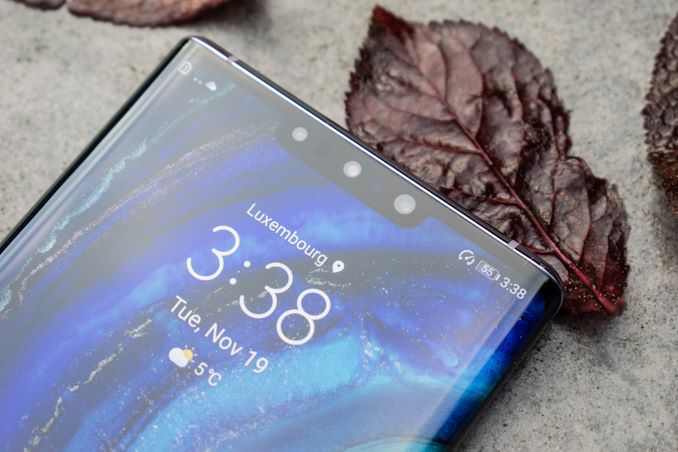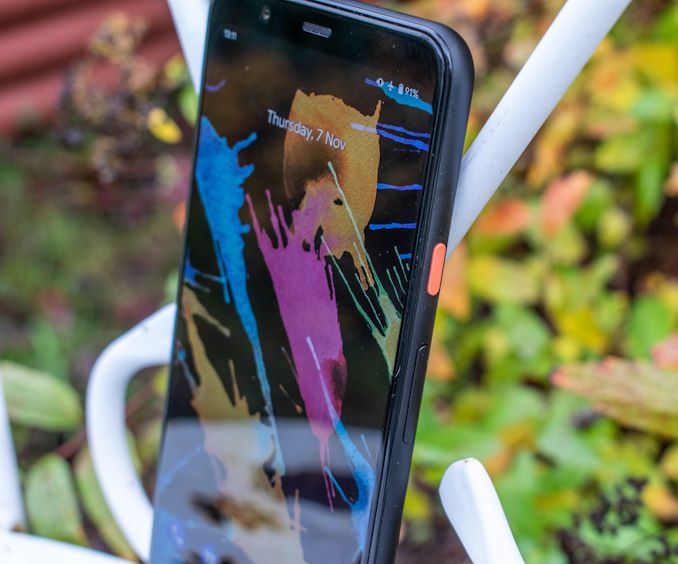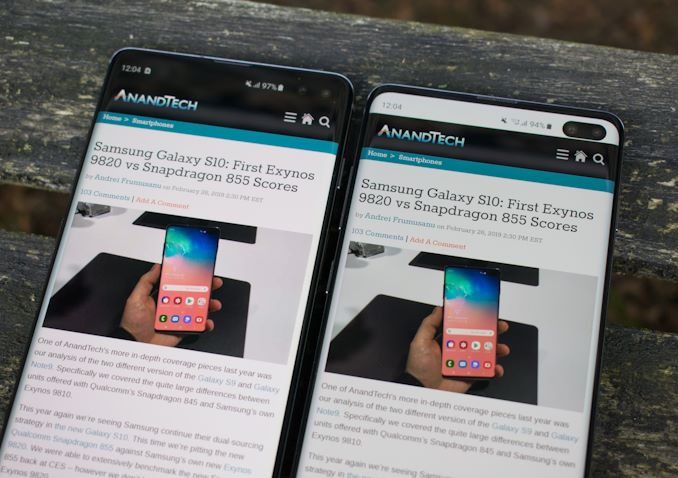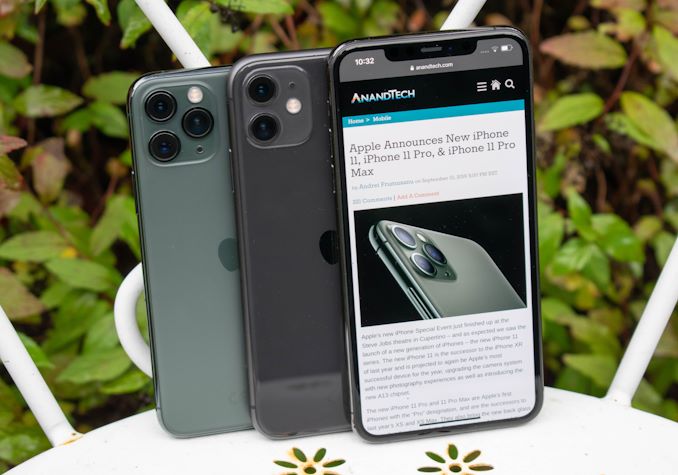AnandTech Year In Review 2019: Flagship Mobile
by Andrei Frumusanu on December 26, 2019 8:00 AM ESTCompanies’ Product Strategies and Execution in 2019
Like last year, it would it would be fitting to summarise 2019 based on each companies’ general efforts and product strategies. Successes of individual devices is likely more linked to a company’s design philosophies for the year, rather than the exact implementations on a given device – especially valid for companies releasing multiple devices per year.
Huawei in 2019 – Successful First Half, Political Turmoil in the Second Half
Huawei began the first half of the year with quite a lot of success with the release of the P30 series. The phones generally impressed thanks to offering a good overall package, differentiating themselves again this year by innovating in the camera department and brining to market among the first prism-based telescopic camera modules, as well as showcasing the first ever RYYB main camera sensor module, offering even better low-light performance.
I felt that the P30 series were a continuation of the design philosophies of the Mate 20 Pro released late last year, which isn’t really a bad thing. Huawei’s success of the series might have been greater if they had priced the phones a bit more competitively, especially in the face of Samsung’s strong showing of the S10 series.
In the second half of the year, or more precisely following the U.S. Commerce Department’s ban in May, is when Huawei’s troubles began. The political move meant that US companies such as Google were prohibited from working with Huawei, essentially banning the company from access to Google’s Mobile Services which includes the Play Store and many other of Google’s first-party applications, not being able to ship new devices to the market with these components preinstalled.
The first major device to suffer from the blow was the Huawei Mate 30. Although the device still is able to use the Android operating system, its lack of a preinstalled Play Store represents a real commercial draw-back. It’s still possible to get access to it post-purchase and to side-load most applications, but that’s not a viable means for the average consumer.
The Mate 30 Pro innovated again in terms of camera hardware, but the rest of the phone didn’t quite impress as much. The edge-to-edge curved display felt more like a gimmick and was bad for ergonomics, and the new Kirin 990 was a smaller than usual upgrade over its predecessor. Given the compromises and the high device price, I don’t think Huawei will be able to repeat a similar level of success as we’ve seen in the P30 or Mate 20 series.
Huawei’s future in western market remains clouded in uncertainty – the company will have to double down delivering outstanding hardware and features in order to overcome its trade-sanctioned handicap.
LG in 2019 – Very Little Substance
LG’s execution in 2019 was one that seemed to cry out for despair in trying to stand out. Whilst the G8 is certainly a much better phone than the G7 last year, it just yet again had some obvious weaknesses such as very inaccurate display colours, for which LG in the past openly stated as not caring about. Features such as the floating hand gesture navigation were pretty much pointless gimmicks that don’t really bring any value to the user experience.
LG made great efforts in the camera department this year, and the main camera quality of the G8, V50 and G8X make it certainly as part of the better cameras of the year. Still, the company lags behind the aspect of computational photography, and the choice of segmenting the G8 series between dual and triple-camera setups depending on country, with western markets only receiving only the dual-camera version means that the device becomes even less interesting.
The G8X’s dual-screen accessory is just another attempt at gimmickry that’s just a cheap response to foldables; the two screens aren’t even able to be set to the same colour temperature / colour profile which makes things look ridiculous, besides the fact that it’s just overly of very little use.
I have no idea where LG is heading – most of the devices weaknesses I feel is just bad product management rather than the company not having the resources to execute. We want an LG device that is able to focus on the core aspects of a phone: A good screen, good performance, good camera and good battery life. If you can’t deliver on these four basics, any other gimmicks on top are just wasted development resources.
Sony in 2019 – Biggest Disappointment
We never had much opportunity in the past to cover Sony devices, so that’s why I was quite excited to be able to finally review a device such as the the Xperia 1. I don’t think that I’ve ever had a device turn my excitant into disappointment just as quickly as the Xperia 1. The phone had been promised as being the first development under new management at Sony, but unfortunately it seems it the phone was doomed to fail right out of its design phase.
The actual physical design of the phone is great; the 20:9 aspect ratio works very well, and Sony’s actual hardware is amongst the best in 2019. The issue is that the marketing choice of actually using a 4K resolution display means that the phone is severely handicapped when it comes to battery life, posting amongst the worst results of any 2019 device. Usually I’m very defensive about high resolution screens on mobile devices and will always immediately prefer a 1440p display over 1080p devices, but even I can’t tell the difference on Sony’s 1644 x 3840 display. It’s a design element that shouldn’t have ever been greenlit by management given its battery life drawbacks.
The cameras, while being excellent in their hardware, completely fail in terms of software processing and functionality, producing some of the worst results in 2019 when it comes to exposure, HDR, and low-light photography – although Sony is showcasing excellent detail in daylight.
OnePlus in 2019 – Ability to Differentiate
OnePlus’ phones in 2019 have been great mostly thanks to the company’s ability to be able to actually differentiate itself from the competition. The OnePlus 7 Pro’s design with a bezel-less 90Hz screen still makes it unique to date, and the company has been able to adopt the 90Hz feature in its more mainstream model with the 7T.
The company’s biggest weakness this year was in the camera department. Although featuring a triple-camera module setup, picture quality from the phones wasn’t quite as great as that of the competition. The problem here seems to solely lie in the company’s software processing. When I first received the OP7Pro it was in the midst of a major software update that promised to improve picture quality. The company purposefully changed the camera processing to be more similar to that of the Pixel 3, including actually introducing commonalities such as degrading crushed shadows which weren’t present on the OP7’s release firmware. I thought this was a stupid move, and do feel somewhat vindicated in my line of though given that the new Pixel 4 fixes this negative aspect of Google’s processing.
If OnePlus manages to get its camera processing in order, phones such as the OnePlus 7 Pro and the 7T likely represent one of the best devices in 2019, and I hope the company is able to continue on this trajectory.
Google in 2019 – Software Is Also Meaningless Without Hardware
Google’s Pixel 4 devices this year weren’t as big of a disappointment to me, but that’s solely simply because I wasn’t expecting too much.
Google has received a reputation of not being able to execute well on its hardware, and the Pixel 4 remains true to this cursed tradition. It’s a similar dilemma as for Sony’s Xperia 1: the design choice of going with a 90Hz display should have never been greenlit, or a least it should have never been greenlit along with the disappointing battery capacities of the phones. Whilst we reviewed the XL variant which ended up quite average in terms of battery life, the smaller Pixel 4 is said to suffer considerably more and simply not being a viable phone in 2019. Google’s choice of going with second-rate hardware components such as a cheaper Samsung panel on the XL as well an LG panel on the regular variant means the phones suffer from low brightness and low power efficiency.
The Pixel 4 is also the only flagship device in 2019 which didn’t come with an ultra-wide-angle camera module, Google evidently didn’t get the memo what the market actually wants, and instead chose to go for a telephoto module for Google’s first ever dual-camera phone, catching up to 2018 devices instead of the new 2019 competition.
Google’s solutions to the situation should be easy: either give up on launching the Pixel phones as super-high-end flagships with top-tier pricing and aim for a lower market segment, or go and actually deliver flagship hardware for that price.
ASUS in 2019 – The Biggest Surprise
I wanted to keep this page limited to the most popular vendors on the market, but one vendor that this year seemed to have punched above its weight was ASUS. The company has had its Zenfone line-up for multiple years now, but never really managed to differentiate itself very much, or always had some big drawbacks. The Zenfone 6 as well as the new ROG Phone II this year seem to have followed a change in philosophy at ASUS, with the company now able to more consistently deliver on the core aspects of a phone.
The ROG Phone II was a stand-out phone this year, and most of that notably had nothing to do with the device’s gaming-oriented design and features. The huge phone impresses through its brute-force approach to hardware. With a 120Hz screen, a Snapdragon 855+ and a gigantic 6000mAh battery, it’s been able to reserve itself a special place in the performance and battery rankings this year. Along with a reasonable camera setup, stereo speakers, and a 3.5mm headphone jack, the device isn’t just a good gaming phone, it’s just an overall good phone.
ASUS should continue with this formula as evidently it’ll be able to carve itself a piece of the pie not only among the gaming audience, but the overall phone market in general.
Samsung in 2019 – The Best of Android
When I reviewed the S10 earlier in the year I had mentioned that it was the first device I had considered giving an award to, and only fell short of it due to the Exynos version’s camera processing weaknesses. Samsung over the course of the year largely fixed these shortcomings via software updates, meaning what we’re left with now is amongst the best devices in 2019.
What makes the S10 series so great is that it doesn’t have any particular weakness. Performance, screen quality, outstanding battery life and camera are all core aspects of a phone which Samsung was able to deliver on. It’s true that in the camera segment it’s now been bested by Apple’s newest iPhones, but that’s also half a year into the S10’s product cycle. The S10 checkmarks all the feature boxes that a phone should have in 2019.
Pretty much the same can also be said for the Note10 series (although the 1080p screen on the regular Note10 is at odds with Samsung’s design history). The sad exception that Samsung has now also fallen prey to abandoning the 3.5mm headphone jack. The Galaxy phones had been the last bastion of resistance against the removal of the jack, but it looks like corporate greed and profit exorbitant profit margins on wireless headphone accessories are just too great a temptation for the company’s management. The integrated 3.5mm headphone jack is now dead for good in the mobile space, and it’s a sad day for the consumer. F.
Apple in 2019 – Boring Excellence
On the outside, the iPhone 11 series are extremely boring phones. Comparing an iPhone 11 Pro to an iPhone X from 2 years ago you wouldn’t know the difference unless you flipped them over to showcase the new camera setup. Yet, these are amongst the best phones in 2019, and Apple’s execution of the core aspects of a phone has seen tremendous improvements for the user experience.
Apple’s vertical silicon integration and in-house development continues to pay off, and leads the industry in terms of performance and efficiency. The A13 maintains or even widens this gap to the competition.
Battery and camera improvements are what makes the iPhone 11 outstanding phones. Apple has finally opted to integrate bigger battery capacities this year, and along with Samsung’s flagships, these are amongst the longest lasting devices in 2019. Apple’s triple-camera setup is fantastically executed, and offers one of the best shooting experiences in 2019. Apple still has to work on the quality of its ultra-wide-angle module, but everything else is class-leading.
There’s not too much to say about the new iPhones other than they’re extremely solid phones. I do wish a new design refresh as the current one is getting a bit long in the tooth, but hopefully that’s in queue for the 2020 models.
Related Reading:
- The Huawei Mate 30 Pro Review: Top Hardware without Google?
- The Google Pixel 4 XL Review: Stuck In The Past In 2019
- The Apple iPhone 11, 11 Pro & 11 Pro Max Review: Performance, Battery, & Camera Elevated
- The ASUS ROG Phone II Review: Mobile Gaming First, Phone Second
- The Nubia Red Magic 3 Review: A 90Hz Gaming Phone With Active Cooling
- The Black Shark 2 Review: A Gaming Phone's Existential Crisis
- The OPPO Reno 10x Zoom Review: Bezeless Zoom
- The Snapdragon 855 Phone Roundup: Searching for the Best Implementations
- The Sony Xperia 1 Review: A 21:9 Take of the World
- The Google Pixel 3a XL Review: Does Mid-Range Make Sense?
- The OnePlus 7 Pro Review: Outstanding Performance & Screen, Adequate Everything Else
- The Honor 20 Pro: A Quad-camera Hands-On Review
- The LG G8 Review: Solid, But Not Great
- The Huawei P30 & P30 Pro Reviews: Photography Enhanced
- The Samsung Galaxy S10+ Snapdragon & Exynos Review: Almost Perfect, Yet So Flawed
- The Apple iPhone XR Review: A Different Display Leads To Brilliant Battery Life
- Honor Launches The View20: A 48MP Camera Review















54 Comments
View All Comments
Tigran - Thursday, December 26, 2019 - link
Why sustained performance is called "Warm", while peak performance - "Cold", isn't it vice versa? And what about Mate 30 Pro & Galaxy 10+ - is there peak performance in the table? If yes - can we see sustained also, please?zanon - Thursday, December 26, 2019 - link
It's describing the thermal condition, because the primary limiter for phone form factors with modern SoCs is passive heat dissipation and thermal throttling. When the phone is cold there is a bit headroom to burst to until it warms up, and once it's warm than whatever the SoC can run at consistently from there on out is the sustained performance. That's a reason even the same SoC can exhibit higher performance in a tablet (or different form factor phone) with more thermal dissipation.Tigran - Thursday, December 26, 2019 - link
I see, so it's initial thermal condition, not final. Thanks!Andrei Frumusanu - Thursday, December 26, 2019 - link
The A12 and A13 have absurd peak power consumption >6W which is far above the general ~4.5W peak that Android SoCs exhibit; but Apple throttles within 2-3 minutes to the "Warm" state. This isn't the full sustained performance figure which is below that.So I chose to add in a second data-point for the Apple SoCs as that gives a better comparison point to the Android SoCs. Because the Android SoCs don't exhibit that abnormal thermal behaviour at peak, there's no need for a second data-point.
Tigran - Thursday, December 26, 2019 - link
I see, thanks. As for me personally, I would appreciate Apple's & SoCs full sustained performance AND avg. power figures also.Andrei Frumusanu - Thursday, December 26, 2019 - link
This article isn't the piece to go over in detail, you can read about it in the full reviews.https://www.anandtech.com/show/14892/the-apple-iph...
https://www.anandtech.com/show/15207/the-snapdrago...
Tigran - Thursday, December 26, 2019 - link
Yes, I'm aware about that figures, but there is Android SoCs PEAK performance with avg. power, not full sustained. E.g. I know Mate 30 Pro's full sustained performance (14 FPS in GFXBench Aztec High), but not the corresponding avg. power.Alistair - Friday, December 27, 2019 - link
Average isn't a useful figure as it just depends on how long you run the test. If you run the test a long time you get the "warm" figure, if you run it a short time you get the "cold" figure, so those are the two important numbers, not the average.GC2:CS - Thursday, December 26, 2019 - link
Wait. Single core CPU takes 6W. Neural engine takes like 4. GPU can take up to 6.I thought A10 was power hungry, but how can those things work at such high power levels, without blowing the (i)phone up ?
What about the A12X ? Is that a 20W part ?
Andrei Frumusanu - Thursday, December 26, 2019 - link
All the blocks never work at peak performance at the same time, so it never sums up to the theoretical 15-20W.